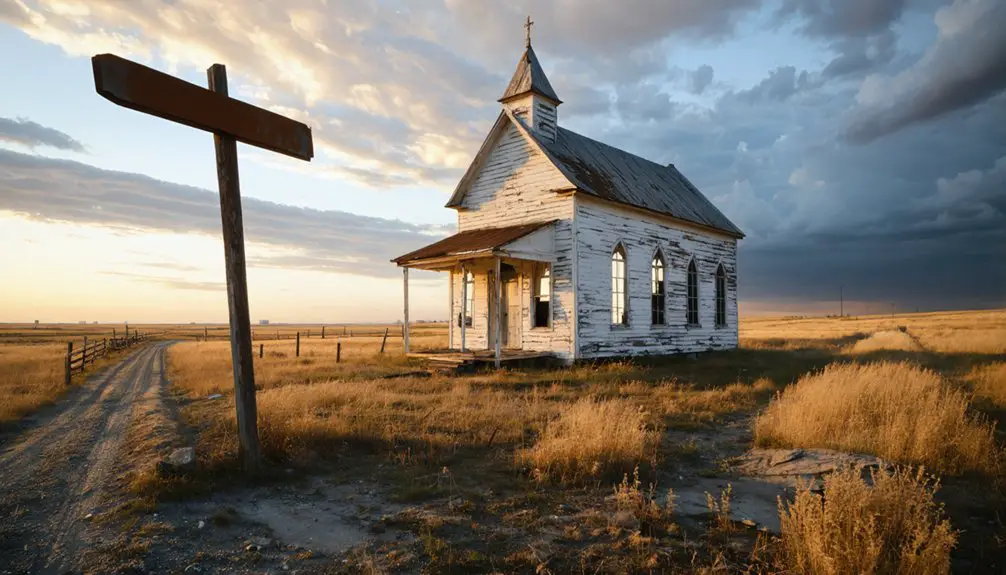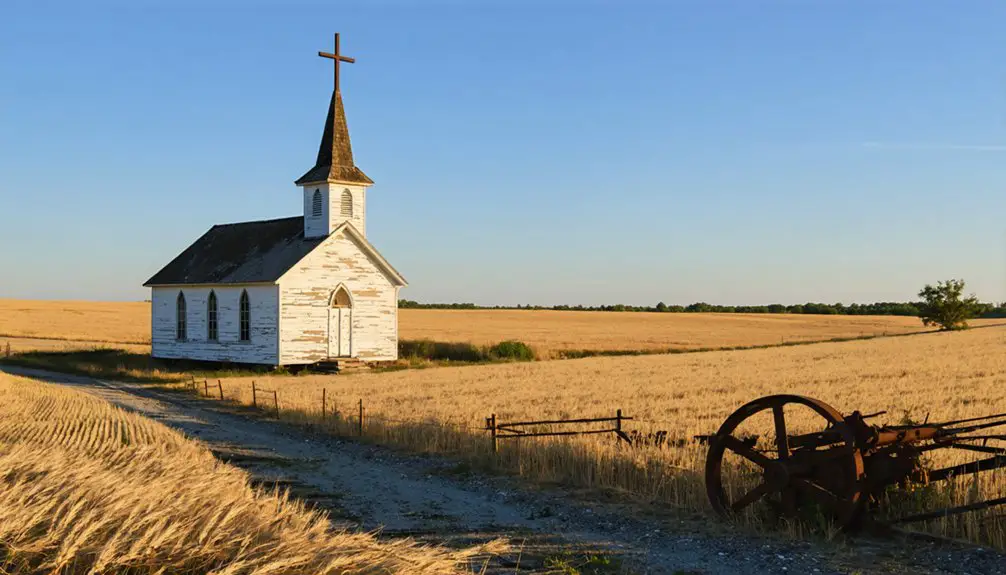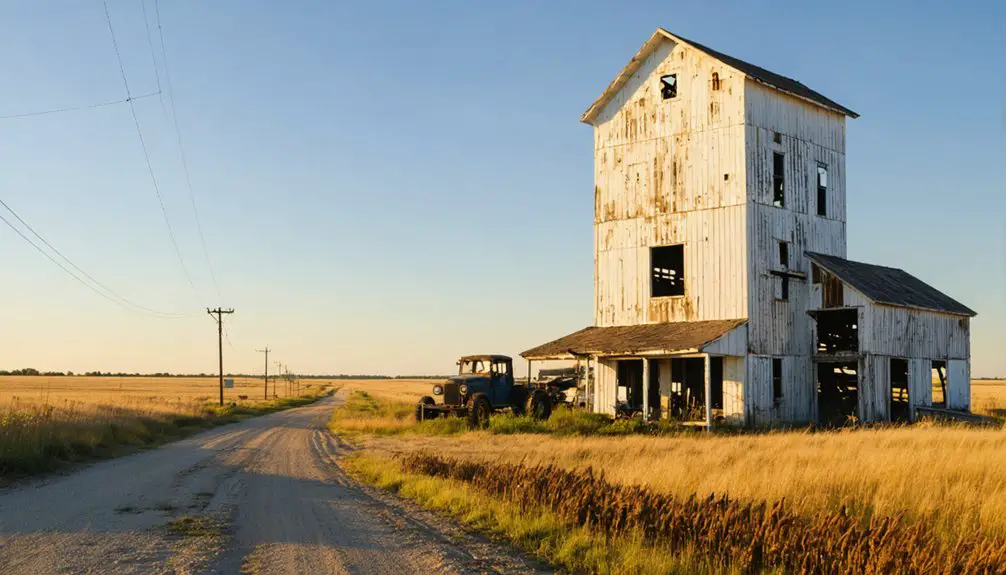You’ll find Leipzig’s ghost town roots in Grant County, North Dakota, where fifteen Bessarabian German-Russian families established a settlement in 1896. While the community thrived and grew to 200 residents by 1909, the Northern Pacific Railroad‘s decision to bypass Leipzig in 1910 proved fatal. The residents relocated to establish New Leipzig nearby, leaving behind their original settlement. The abandoned site now stands as a tribute to the region’s rich German-Russian heritage, with untold stories waiting in its silent remnants.
Key Takeaways
- Leipzig became a ghost town after the Northern Pacific Railroad bypassed it in 1910, forcing residents to relocate to New Leipzig.
- Originally established in 1896 by fifteen German-Russian families from Bessarabia, Leipzig grew to 200 residents by 1909.
- The Trinity Lutheran Church, built in 1902, remains a historic landmark of the abandoned Leipzig settlement.
- Isolation and limited commerce opportunities following the railroad bypass led to the community’s eventual abandonment.
- The original settlement’s remnants preserve the heritage of German-Russian immigrants who first settled in Grant County, North Dakota.
The Origins Behind Leipzig’s Name
While the name Leipzig has deep historical roots stretching back to 1015, its Slavic origins tell the story of a “settlement by the lime trees.” This ancient place name emerged from the cultural mixing of Slavic and Germanic peoples in medieval Europe, specifically in what would become eastern Germany. Today, this historical city stands as the eighth-largest in Germany.
You’ll find the name’s significance carried forward through generations of German settlements, beginning with an 1844 colony in Bessarabia established at the Austrian Emperor’s request. The settlement would later face a dramatic change when it was bypassed by railroad in 1910.
This cultural preservation continued when German-Russian families from Bessarabian Leipzig immigrated to North Dakota in 1896, bringing their cherished name with them. When they founded their new community in Grant County, they chose Leipzig as a powerful symbol of their heritage, maintaining crucial connections to their European roots.
From Bessarabia to Dakota Territory
You’ll find remarkable continuity between Leipzig’s Bessarabian roots and its Dakota Territory manifestation, as fifteen families from the original German colony made the arduous journey by train to Grant County in 1896.
These pioneers carried with them not just their physical possessions, but also their cultural identity, religious practices, and even their hometown’s name – establishing Leipzig as their new prairie settlement.
Their determination to preserve their German-Russian heritage while building a new American community reflected the broader pattern of Bessarabian German immigration to the Dakotas during the late nineteenth century.
The settlers continue to honor their heritage through an annual Oktoberfest celebration that began in 1971.
When Trinity Lutheran Church was built in 1902, it became the spiritual cornerstone of the growing German-Russian settlement.
Early Immigrant Settlement Patterns
During the late 19th century, German immigrants from Bessarabia began a significant migration to Dakota Territory, driven by the Russian government’s 1870s policy changes that enforced compulsory military conscription. Nearly one-third of North Dakotans today can trace their ancestry to these German-Russian settlers. The similarity between Dakota Territory and the Russian steppes landscape made the region particularly appealing to these immigrants.
You’ll find their settlement patterns were shaped by both immigrant motivations and settlement challenges as they sought land resembling their familiar Russian steppes.
These pioneers established themselves through:
- Initial stops at established colonies before moving to permanent homestead sites
- Strategic settlement near lakes and rail lines for water access and transportation
- Formation of distinct religious communities including Lutheran, Catholic, and Mennonite congregations
They’d often relocate when land wasn’t available, spreading across rural tracts in places like McLean and Stark Counties.
Their communities grew through chain migration, with new arrivals joining family members who’d already established farms in the territory.
European Roots Run Deep
As German-Russian settlers established Leipzig in North Dakota, they carried forward a rich cultural lineage that stretched from Germany through Bessarabia to the American prairie.
In 1896, fifteen families made the journey from their Bessarabian home of Leipzig, itself named after the German city, to forge a new life in Dakota Territory. By 1909, the settlement had grown to include 200 residents.
You’ll find their cultural continuity reflected in how they preserved their heritage. These pioneers maintained their German language, religious practices, and traditional festivals while adapting to frontier life.
Their ethnic identity remained strong through their architectural choices in churches and schools, which mirrored European styles.
Even when the railroad’s bypass forced them to relocate in 1910, they established New Leipzig, ensuring their community’s bonds and traditions would endure on the prairie.
Building Prairie Pioneer Communities
The prairie pioneers of Dakota Territory faced immense challenges when establishing their frontier communities in the 1860s and beyond. Their pioneer resilience showed in their settlement strategies, from digging deep wells to creating shelter belts that protected their homesteads from harsh winds. During the Dakota Boom period between 1870-1880, settler populations surged dramatically as pioneers sought new opportunities in the territory. Many settlers brought their traditional skills from their home countries, helping them adapt to frontier life.
You’ll find these essential elements of frontier survival:
- Adapting to scarce resources by using alternative fuels like buffalo chips and hay twists for heating
- Building protective barriers against severe weather through strategic tree plantings
- Establishing wells 40-60 feet deep to secure crucial water sources
Railroad expansion in the 1870s transformed these isolated settlements, bringing new opportunities and immigrants from Northern and Western Europe.
Despite threats from prairie fires and brutal blizzards, these determined settlers built lasting communities through innovation and grit.
Life in Early Leipzig Settlement
If you’d visited Leipzig in its early years, you’d have found German-Russian families following traditional agricultural rhythms – planting in spring, harvesting in fall, and weathering harsh Dakota winters through community support.
The town’s social fabric was woven through regular church services, holiday celebrations, and community gatherings where settlers maintained their Bessarabian customs and German language.
Your daily encounters would have revealed a close-knit farming community of about 200 residents who relied on shared cultural traditions and mutual aid to overcome the challenges of frontier life.
Daily Agricultural Routines
Daily agricultural routines in Leipzig’s early settlement centered on a carefully orchestrated rhythm of crop cultivation and livestock management that defined settlers’ lives from dawn to dusk.
You’d start your day tending to livestock, ensuring animals were fed, watered, and healthy before moving on to fieldwork and crop rotation duties.
Key daily activities included:
- Morning livestock care – milking cows, feeding horses and hogs
- Seasonal fieldwork – plowing, planting, or harvesting depending on time of year
- Evening animal checks and securing buildings for the night
Your success depended on mastering these routines while adapting to North Dakota’s challenging climate.
You’d grow hardy wheat varieties like Kota, maintain kitchen gardens for household needs, and preserve food through various methods to sustain your family through winter.
Many residents were Germans from Russia, who maintained strong cultural traditions while adapting their agricultural practices to the region.
Community Gatherings and Events
While Leipzig’s settlers devoted much of their time to agricultural work, community gatherings served as essential touchstones of social and cultural life in the early settlement.
You’d find vibrant community events centered around the local churches, where both English and German services reflected the settlement’s German-Russian heritage. Cultural celebrations included annual potlucks in churchyards and family reunions that strengthened social bonds.
When the Northern Pacific Railroad bypassed Leipzig in 1910, you’d have witnessed the community’s resilience as they gathered to plan their relocation to New Leipzig.
Even after the move, seasonal festivals and harvest celebrations continued to unite residents.
Today, bronze plaques and historical markers commemorate the original townsite, where visitors still gather to honor the settlement’s legacy through organized remembrance events.
German-Russian Cultural Traditions
The German-Russian settlers of Leipzig brought with them a rich tapestry of cultural traditions from their Bessarabian homeland.
You’ll find their dedication to cultural preservation evident in how they maintained their German language, religious practices, and traditional farming methods in their new prairie home.
The settlers’ commitment to their heritage was reflected in three key ways:
- Daily use of German dialects in homes and community gatherings
- Practice of folk customs, songs, and storytelling passed down through generations
- Preservation of traditional farming techniques adapted from their Eastern European experience
Their Lutheran faith served as a cornerstone of cultural identity, with Trinity Lutheran Church becoming both a spiritual center and a symbol of their German-Russian heritage.
Through extended family networks and strategic marriage choices, they’ve maintained their unique cultural identity in the North Dakota frontier.
The Railroad’s Fatal Bypass
In 1910, Northern Pacific Railroad‘s fateful decision to bypass Leipzig proved catastrophic for the burgeoning North Dakota settlement. By choosing a route 11 miles southwest, the railroad’s impact effectively isolated the town from essential transportation networks.
When the Milwaukee Railroad also bypassed Leipzig, you’d have witnessed the town’s swift decline as residents faced the harsh reality of limited commerce and communication options.
The community fragmentation that followed tore at Leipzig’s social fabric. You would’ve seen roughly 200 residents, mostly German-Russian settlers, make the difficult choice to abandon their established homes and relocate near the new rail line, founding New Leipzig.
Relocation and Birth of New Leipzig

Following the railroad’s pivotal bypass decision in 1910, determined German-Russian settlers established New Leipzig 11 miles southwest of their original settlement. This strategic relocation preserved their community’s historical significance while securing essential rail access for their future.
You’ll find these defining characteristics of New Leipzig’s birth:
- Settlers chose the name to honor their Germanic roots, briefly changing to “Lawther” in 1912 before successfully reclaiming “New Leipzig.”
- The town rapidly developed infrastructure, including a post office and two-story wooden schoolhouse built in 1912.
- Residents brought their rich Bessarabian German heritage, later celebrated through events like Oktoberfest starting in 1971.
Today, a bronze plaque marks the original Leipzig site, testament to the community’s resilient spirit and cultural preservation.
Remnants of a Lost Community
Scattered across the original Leipzig townsite, several enduring structures offer glimpses into this lost community’s past, including churches and a schoolhouse that have weathered decades of abandonment.
You’ll find the original post office building, which served as the town’s first community infrastructure from 1896 until 1915, standing as a silent tribute to Leipzig’s former significance.
At the four corners where Leipzig once thrived, a bronze plaque installed in 1960 preserves the cultural memory of this settlement.
The remaining wooden structures, typical of early 20th-century rural architecture, tell the story of a community that peaked at 200 residents before being bypassed by the railroad in 1910.
Leipzig’s weathered wooden buildings stand as silent witnesses to a once-thriving prairie town, abandoned after the railroad chose a different path.
While the buildings continue to decay, they serve as powerful reminders of North Dakota’s German-Russian immigrant heritage.
Legacy of German-Russian Heritage

German-Russian settlers who founded Leipzig brought with them a rich cultural heritage that would deeply shape North Dakota’s identity. Their cultural identity centered on the Lutheran Church, which served as both a spiritual anchor and a symbol of their resilience through multiple migrations.
You’ll find their lasting impact reflected in these key developments:
- The formation of the Germans from Russia Heritage Society in Bismarck, preserving genealogies and cultural records.
- The religious significance of Trinity Lutheran Church, which settlers traveled miles to attend despite railway developments.
- The architectural legacy visible in century-old churches and homes across North Dakota’s landscape.
Today, their influence remains evident in North Dakota, where German-Russians came to represent 30-40% of the state’s population, leaving an indelible mark on the region’s cultural fabric.
Frequently Asked Questions
What Was the Average Land Price for Leipzig Settlers in 1896?
You’d have paid around $1.25 per acre through homesteading in Leipzig’s 1896 land valuation, though settlement patterns show many settlers secured 160 acres through minimal filing fees or improvement claims.
How Many Original Leipzig Buildings Still Remain Standing Today?
Like ghosts fading into the prairie mist, you won’t find exact records of original architecture today. While historical preservation efforts are limited, you’ll see only a handful of deteriorating structures still standing.
Were There Any Notable Conflicts Between Leipzig Residents and Native Americans?
While historical records don’t document specific conflicts between Leipzig settlers and Native Americans, the area experienced broader regional tensions over settler relations and land disputes during the 1862-1864 Dakota Wars.
What Crops Were Primarily Grown by Leipzig’s Earliest Farmers?
You’d find wheat production dominated Leipzig’s early fields, with farmers practicing crop rotation using oats, corn, flax, and barley. Wheat’s economic importance earned it the nickname “King Wheat.”
Did Any Leipzig Families Choose to Stay After the Railroad Bypass?
You’ll find that while most families moved for railroad access, some did remain near the original site, maintaining structures like churches and schools, showing community resilience despite the railroad’s impact on Leipzig.
References
- https://en.wikipedia.org/wiki/Leipzig
- https://news.prairiepublic.org/show/dakota-datebook-archive/2022-06-10/old-leipzig-born
- https://newleipzig.com/history
- https://www.youtube.com/watch?v=0b8AdqgtexA
- https://northernsentry.com/2025/06/26/north-dakota-ghost-towns/
- https://en.wikipedia.org/wiki/List_of_place_names_of_German_origin_in_the_United_States
- https://cdn.saffire.com/files.ashx?t=fg&rid=DickinsonCVB&f=Current__Ghost_towns_-_A.pdf
- https://www.blackseagr.org/pdfs/konrad/History-Leipzig.pdf
- https://leipglo.com/2015/05/12/new-leipzig-north-dakota/
- https://www.blackseagr.org/pdfs/konrad/Bessarabia Presentation – 2010 Text.pdf



